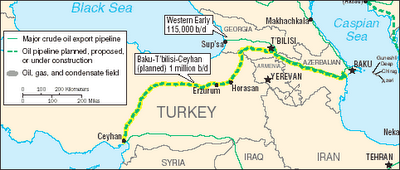
Specifications
The total length of the pipeline is 1768 kilometers, of which 443 kilometers lies in Azerbaijan, 249 kilometers in Georgia and 1076 kilometers in Turkey.
The pipeline is mostly 42 inches in diameter, widening to 46 inches in Georgian and the small part of Turkish section, and narrowing to 36 inches diameter near Ceyhan.
The pipe's wall thickness ranges from 8,74 to 23,8 millimeters.
The pipeline has 8 pumping stations: two in Azerbaijan, two in Georgia and 4 in Turkey.
The pipeline’s capacity is 1 million barrels per day. It takes 10 days for crude oil to reach its final destination.
Huge oil terminals have been constructed in Sangachal, Azerbaijan and Ceyhan, Turkey.
Construction of the pipeline started in April of 2003, and its filing with oil on May 18, 2005.
The oil appeared in Georgian section of the pipeline on August 10, 2005, Turkish section on November 18, 2005, and reach Ceyhan terminal on May 28, 2006.
A total of 110 million man-hours have been worked for the construction of the pipeline.
In total, 220.000 pipes have been welded together.
Along its route the pipeline travels through 1500 rivers and 13 seismic faults.
The highest place the pipeline passes through is in Turkey at the elevation of 2800 meters above sea level.
The pipeline was buried along its entire route, and crossed 500 settlements without move of a single resident during construction activities.
Main contractors are: CCIC in Azerbaijan, Spie Petrofac in Georgia and turnkey contractors BOTAS to implement the Turkish Section of the BTC pipeline.
Planned annual capacity of the Baku-Tbilisi-Ceyhan pipeline is 50 billion tons of oil.
Over 400.000 barrels a day are transported currently by the BTC pipeline.
In 2008, the pipeline will carry 1 million barrels of oil daily

Cost and finance
Implementation of the BTC pipeline project came to 4 billion dollars. (It concerns construction activities only - the cost of the pipeline’s filling with oil, and bank interest charges are not included).

The total amount of the loans provided for the BTC project is 2.6 billion dollars. The providers are:

The International Finance Corporation (IFC) and European Bank of Reconstruction and Development (EBRD);

Export credit agencies and political risk insurance companies from 6 countries including UK, USA, Germany, Japan, France and Italy;

Fifteen commercial banks lead by ABN Amro, Citigroup, Mizuho and Societe Generale;
The companies BP, Statoil and ConocoPhillips provided loans as main sponsors.

Employment
Workforce of about 22.000, 70-80% of which locals, was involved when construction activities were in full swing. After it is put into operation, the pipeline will employ some 850 on a permanent basis.
Public Relations
450 communities (about 750.000 people) including some 100.000 landowners were registered to be affected by the pipeline along the route.
The landowners had been paid $133 million US dollars of indemnity until the end of 2003.
22.000 agreements on lease of land parcels have been signed.
A $25 million grant have been awarded for implementation of the Community Investment Program, from which 500 communities including 115 in Azerbaijan have benefited.
The program started in July 2003 will continue by the end of 2006.
In Azerbaijan, the Community Investment Program was implemented by Community Assistant Fund, International Rescue Committee, Save the Children and International Medical Co.; in Georgia Care International and Marcy Co.; in Turkey Ataturk University, SURKAL and International Blue Crescent.
32 medical units, 43 schools and 100 kilometers of roads were constructed, 314 doctors and 2.700 farmers took training courses, 184.000 people were rendered medical aid, and 15.800 micro-credits were granted under the program.
Environment
Precautionary and some additional measures to protect environment and cultural heritage were taken in the following areas along the pipeline’s route:
Borjomi National Park (Georgia)
Erzurum lowland (Turkey)
Posof (Turkey)
Ktsia-Tabatskuri Preserve (Georgia)
Gobustan cultural preserve (Azerbaijan)
The total cost of the Environment Investment Program, as well as the projects to protect turtles, black tetra fish, bears and seals, is 9 million dollars. Five million dollars were spent on archeological monitoring.
Monitoring
On behalf of creditors, a quarter-long environmental and social monitoring by the company D’Appollonia;
On behalf of creditors, 6-month social monitoring and that of the plan of land parceling, by the independent experts’ council;
A 12-month monitoring by Caspian Development Advisory Panel;
Monitoring and analysis by NGOs: In Azerbaijan by the Open Society Institute, in Turkey by TESEV through implementation of the population involvement program, in Georgia by TBC;
Human rights monitoring by Foley Hoag
BTC Co. Shareholders
BP (30,1 %); AzBTC (25 %); Shevron (8,90 %); Statoil (8,71 %); TPAO (6,53 %) ; ENİ (5 %); Total (5 %), İtochu (3,40 %); İNPEKS (2,50 %), KonokoPhillips (2,50 %) and Amerada Hess (2,36 %).
Historic milestones
September 20, 1994: signing of the Contract of the Century;
November 18, 1999: Presidents of Azerbaijan, Turkey and Georgia come together in Istanbul to sign an Agreement on transportation of crude oil through the Baku-Tbilisi-Ceyhan main export pipeline;
August of 2002: the company BTC Co. is founded in London to construct and further exploit the pipeline;
September 18, 2002: foundation stone of the Baku-Tbilisi-Ceyhan main export pipeline is laid in Baku with the Presidents of Azerbaijan, Turkey and Georgia, and US Energy Secretary in attendance;
May 25, 2005: inauguration of the Azerbaijan section of the pipeline, and filling it with the first oil in Sangachal terminal;
October of 2005: inauguration of the Georgian section of the pipeline;
May 28, 2006: Azeri oil reaches Ceyhan terminal;
June 16, 2006: Presidents Ilham Aliyev of Azerbaijan and Nursultan Nazarbayev of Kazakhstan meet in Astana to sign an agreement to encourage and create conditions for the Kazakh oil to be delivered from Kazakhstan through the Caspian Sea to Azerbaijan, and through the Baku-Tbilisi-Ceyhan main export pipeline to the world market;
June 4, 2006: first tanker filled with the Caspian oil dispatches from the port of Ceyhan to Europe;
July 13, 2006: Official inauguration of the pipeline in Ceyhan.
No comments:
Post a Comment